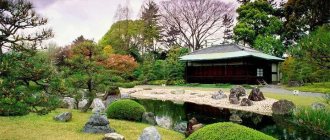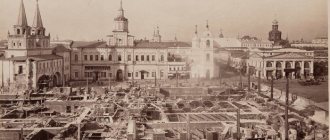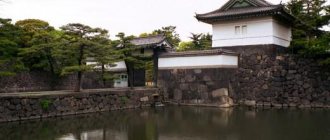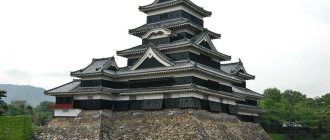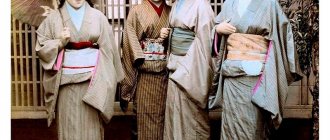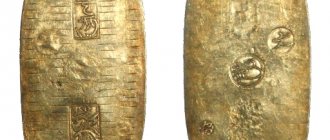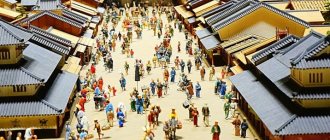Archaeologists and historians have information about the development of Japan from the period of the 40th millennium to the beginning of the current era. The first written source of information about the country in the archipelago is the “Twenty-Four Stories” written down in the first century AD, created by Chinese historians. Much more is known about what Japan was like in the 18th century than about the most ancient stages of the development of the power, and the richness of that era with events leaves historians a huge field of activity - the possibilities for study and clarification are endless.
Land of the Rising Sun
Early 18th century
Japan in the early 18th century was ruled from Edo, although the status of the capital at that moment belonged to Kyoto. Osaka was the largest economic center. The Tokugawa clan was in charge - Tokugawa Ieyasu received the status of shogun from the emperor back in 1603. The clan retained its leadership for centuries - the Tokugawa era lasted from the 17th to the 19th centuries. In the annals of history it is called the Edo era.
Since the beginning of the 18th century, the Land of the Rising Sun found itself in a difficult economic situation. A crisis erupted across the islands as the subsistence economy collapsed under the influence of monetary relations that spread into the countryside. The economic crisis was determined by a decrease in the price of rice, a local budget deficit, and a shortfall in the treasury. Taking into account the experience of the 16th century and the crises of other eras, Tokugawa Yoshimune, who held the reins of power, determined the direction for reform. The new policy began in 1716 under the motto "Kehoe's Reforms." Tokugawa called on officials to be thrifty, and peasants to develop new lands; At the same time, the tax rate increased and “Provisions on Legal Proceedings” appeared, regulating court cases and allowing ordinary people to complain about unscrupulous managers.
Edo in the 18th century
The first years of reform were not easy. Over time, the shogun's ideas were developed by the roju Tanuma Okitsugu. He proposed to focus on merchant corporations, granted them monopoly trade rights, and tried to develop monetary relations on the islands. The result was unexpected: along with the merchants, bribes came into political circles, and the country lost even more. Having suffered a collapse, Tanuma Okitsugu resigned, his work to change the economic model was taken over by Matsudaira Sadanobu, who proclaimed the motto “Kansei Reform”. This time was called the era of “richness through savings.” It was not possible to solve the problems completely - only in the 19th century did some of the initiatives of the 18th century bear fruit. The next reformer after Matsudaira was Tokugawa Ienari, who shifted his emphasis to urban prosperity and the development of trade.
Sela
The Japanese economy of the Edo era was semi-subsistence in nature and dependent on tribute rice supplies. Its collection was carried out in villages by local officials - village heads nanusi or shoya, heads of fives and peasant delegates who controlled communal arable land, mountains and waters, and also performed various administrative functions. Decisions were made collectively. Residents of the villages were divided into fives, their members were in mutual responsibility, jointly paying tribute and preventing the commission of crimes. In one village, there were customs of mutual assistance between the fives.
Need advice from a teacher in this subject area? Ask a question to the teacher and get an answer in 15 minutes! Ask a Question
In order to stabilize the supply of tribute in rice, the shogunate banned the sale of land and limited the peasants, concentrating them exclusively on field work and various duties. Most villages paid taxes on time, considering them a matter of national importance. However, sometimes exorbitant exactions forced peasants to complain to the daimyo or directly to the shogun, or, in extreme cases, to start peasant uprisings.
Development of culture and science
The beginning of the 18th century in the cultural history of the eastern archipelago is marked by the names of Mabuchi, Ihara, Chikamatsu, Hishikawa. Osaka becomes a cultural center along with the capital Kyoto. In history, this time was dubbed Genroku in contrast to Kasse - the era when influences from Edo dominated. During the Genroku period, ukiyo-dhoshi appeared - a new literature characterized by short illustrated stories dedicated to urban everyday life and the life of ordinary people.
The cultural history of the 18th century in the Japanese archipelago is also marked by the formation of ukiyo-bon. This is the name given to modern books about the lives of ordinary citizens.
The Ninge-jururi puppet theater is actively developing. Chikamatsu Monzaemon made a special contribution. Ukiyo-e prints appeared under the influence of Hishikawa Moronobu. Increasingly, the attention of artists was attracted to the life of common people. At the end of the 18th century, hedonistic teachings gained popularity.
Cultural flourishing of the 18th century
Mabuchi Kamo actively influenced modern culture, feeling that in conditions of isolation the country needed to focus on its roots. He realized that the time for imitation had passed, it was time to stop so carefully obeying the tenets of Confucianism, but he needed to follow his own unique path. He called on his contemporaries to study the ancient history of their native places, remember Shintoism and develop culture in this direction. Artists, poets, playwrights were imbued with his ideas, paid attention to the life of the common population, and merchants took an active part in the cultural life of cities. Genroku is the heyday of the Noh, Bunraku, and Kabuki theaters.
The 18th century was characterized by interest in natural disciplines. The focus of the scientific community is agronomy and mathematics. Commoners attended public schools, and government schools worked for the samurai class. The institutions taught writing, reading, arithmetic, Japanese studies, Dutch studies, and Confucianism.
Preference in food and drinks
The Japanese love to eat tasty and satisfying food. Europeans and Americans are sure that in Japan people only eat sushi, rolls, sukiyaki and other exotic dishes that are available in restaurants around the world. In fact, this is not true. Different types of restaurants serve almost the same dishes. There are several types of places where you can eat:
- Shokudo – all visitors must be seated in a circle.
- Izakaya - pub.
- Okonomiyaki - visitors are allowed to participate in the preparation of dishes. Here you can order meat, vegetables, and seafood, which are wrapped in dough mixed with vegetables and cabbage and fried.
- Robotayki is a type of village restaurant where all the food is cooked on charcoal and grill.
- Restaurants where food is prepared at the table. They serve beef, vegetables, which are boiled in broth (sukiyaki dish) or nabemono (this is a soup in which all the elements for it are chosen by visitors. For this, trays with raw products are placed next to them).
- Establishments that serve camp lunches (the so-called benthos or shokudo).
- Cafes and inexpensive restaurants - you can try teishoki.
The Japanese are quite a drinking nation. Alcoholic drinks are consumed by both men, women, and teenagers. First of all, beer is popular. It is sold everywhere - from kiosks, street stalls, supermarkets, shops, temples. In second place in popularity is rice vodka or sake, which should be drunk either cold or warm (it gets to your head very quickly). The Japanese also drink a lot of green tea, which contains a lot of caffeine and vitamin C. It is used to quench thirst, to restore strength, to saturate the body with useful minerals, and to prevent cancer.
Economic decline
The 18th century was a period of economic transformations, among which there were both successful and downright ineffective. Against the backdrop of the famine experienced in the 30s, rice fields were expanded, expenses for maintaining the court and officials were reduced, and the death penalty was imposed for bribery. The peasants lived under feudal lords and could not change their master; their duties included repairs, construction work, supply of horses, and porters.
The economic crisis began already in the second decade of the century and intensified by the middle of the century. The government prohibited the export from the state of what was consumed within the country; in 1752, a ban on the export of gold was introduced. In the second half of the century, natural disasters struck the archipelago - droughts, hurricanes, earthquakes. Food shortages and hunger provoked riots. In 1772 there was a big fire; a year later, typhus swept the country. New natural disasters, disease and famine began immediately after the epidemic, and the government, left without money, tried to increase taxes. In 1787, the largest “rice riot” occurred in Edo. The rebels plundered merchant houses and rice warehouses in the city. It seemed that peace would never come to the country.
Tokugawa Ienari
Painting
The artistic culture of medieval Japan has been studied by many specialists. Kaiga painting, which in Japanese means drawing or painting, played a huge role in its development. This art is regarded as the oldest type of painting in the state, which is determined by a huge number of solutions and forms.
In it, nature occupies a special place, which defines the sacred principle. The division of painting into sumi-e and yamato-e has existed since the tenth century. The first style developed closer to the fourteenth century. It is a kind of monochrome watercolor. Yamato-e are horizontally folded scrolls that were usually used in the design of works of literature.
A little later, in the 17th century, printing on tablets - ukiyo-e - appeared in the country. Masters depicted landscapes, geishas, and famous Kabuki actors. This type of painting had a strong influence on the art of Europe in the 18th century. The emerging trend was called “Japanism”. In the Middle Ages, Japanese culture went beyond the country's borders - it began to be used in the design of stylish and fashionable interiors around the world.
Second half of the 18th century
In the second half of the 18th century, the main characters in the apparatus of officials were people from the simple samurai families of Tadamitsu Ooka and Okinugu Tanuma. Okinugu, who was interested in crafts, turned out to be especially useful for the state. He established control over spending and revenues to the treasury and appreciated the importance of trade, approved the formation of merchant guilds, which turned into monopolies. Okinugu proposed improvements to irrigation systems to increase the yield of fields, intensified the settlement of Hokkaido and made the development of new fields more profitable for the population.
The next step out of the crisis was the reforms of Kansei Sadanobu Matsudaira. He further cut the financial support of officials, introduced taxes for large landowners, obliged feudal lords to stockpile rice in case of famine, and reduced the labor duties of peasants.
The end of the 18th century was marked by contact with Russia: in 1792 an embassy was sent under the leadership of Laxman. Although the ship was allowed to land in Nagasaki, the negotiations were unsuccessful, and the arrivals did not receive permission to trade.
Nagasaki today
Poetry
The artistic culture of Ancient Japan is still being studied. Its peculiarity is its versatility, some syntheticity, since it was formed under the influence of different religions. It is known that Japanese classical poetry emerged from everyday life, acted within it, and this down-to-earthness was to some extent preserved in the traditional forms of modern poetry - the three-line haiku and the five-line tanka, which are distinguished by a pronounced mass character. By the way, it is precisely this quality that distinguishes them from the “free verse” that tends towards elitism, which appeared at the beginning of the 20th century in Japan under the influence of European poetry.
Have you noticed that the stages of development of Japanese artistic culture are multifaceted? Poetry played a special role in the society of this country. One of the most famous genres is haiku, which can only be understood by becoming familiar with its history.
First appearing in the Heian era, it was similar to the renga style, which was a kind of outlet for poets who wanted to take a break from the thoughtful waha poems. Haikai developed into its own genre in the 16th century as renga became too serious and haiku relied on spoken language and was still humorous.
Of course, the artistic culture of Japan is briefly described in many works, but we will try to talk about it in more detail. It is known that in the Middle Ages one of the most famous Japanese literary genres was tanka (“laconic song”). In most cases, this is a pentaverse, consisting of a pair of stanzas with a fixed number of syllables: 5-7-5 syllables in three lines of the first stanza, and 7-7 in two lines of the second. As for the content, the tank uses the following scheme: the first stanza represents a specific natural image, and the second reflects the human feeling that echoes this image:
- In the distant, remote mountains, the long-tailed pheasant is dozing - This long, long night, can I really sleep alone? (Kakinomoto no Hitowaro, early 8th century, translation by Sanovich.)
Restoration (American model)
Economic recovery took place in the 20th century. Japan, inspired by the American victory, chose the Western model of development. The emperor renounced his connection with the gods, trade unions raised their heads, women received social rights, and society started talking about freedom of religion and political views. Socialists, communists and other oppositionists had the opportunity to speak out. In 1947, they adopted a constitution focused on the ideas of freedom and pacifism, and carried out a land reform that eradicated large-scale land ownership. The peasants finally became land owners.
Under the influence of Joseph Dodge, who proposed a “shock therapy” plan for economic stabilization, tax reform was carried out, the government supported banks, and responsibility for loans transferred to private financial institutions. The result was the stabilization of the domestic currency, simultaneously with the elimination of the budget deficit and the intensification of foreign trade.
The economy was recovering under American influence
Influence
How did Japanese artistic culture develop? Civilization was significantly influenced by the isolated regional location of the country, climatic and geographical features, as well as natural phenomena (typhoons and frequent earthquakes). This was expressed in the extraordinary attitude of the population towards nature as a living being. A feature of the Japanese national character is the ability to admire the flowing beauty of the Universe, which is expressed in many types of art in a small country.
The artistic culture of Japan was created under the influence of Buddhism, Shintoism and Confucianism. These same directions influenced its further development.
Free swimming
By the end of the occupation regime, the economy had recovered, and the country had moved to an average level of development. Delegations of entrepreneurs and scientists from the Land of the Rising Sun have become welcome guests at world conferences, courses, and exhibitions. It was possible to reconstruct all industrial sectors, shifting the emphasis from light industry to heavy and knowledge-intensive. Active import of technologies and units allowed us to save time and money and create a universal industrial structure using advanced developments.
Manga and anime
Many artists are trying to study Japanese painting. What is anime (Japanese animation)? It differs from other animation genres in its greater focus on the adult viewer. Here there is a duplicative division into styles for a unique target audience. The measure of fragmentation is the gender, age or psychological portrait of the movie viewer. Very often, anime is a film adaptation of a Japanese manga comic, which has also gained great fame.
The basic part of the manga is intended for an adult viewer. As of 2002, about 20% of the total Japanese book market was occupied by manga comics.
Japan is close to us geographically, but despite this, for a long time it remained incomprehensible and inaccessible to the whole world. Today we know a lot about this country. Long voluntary isolation has led to the fact that its culture is completely different from the cultures of other states.
Agriculture
The peaceful era of Genroku allowed peasants who had previously fought as foot soldiers to concentrate on agriculture. Small feudal lords, previously involved in wars without fail, devoted all their efforts to developing the lands. The 18th century in Japan was marked by a significant expansion of irrigation systems and plowing of virgin lands. Trade crops were especially actively grown - tea, cotton, safflower. Rapeseed, hemp fields and indigo plantations appeared throughout the country.
Genroku period - era of agricultural development
Class system
Japanese society in the 17th-18th centuries was divided into classes based on professional characteristics. Traditional historiography distinguishes four main classes:
- Military;
- Peasants;
- Craftsmen;
- Traders.
The latest historical science identifies slightly different ones:
- Samurai;
- Peasants;
- Bourgeois (craftsmen and traders);
- Aristocrats;
- Clergymen.
The society was controlled by military samurai, who were responsible for the defense of the country and the performance of administrative and civil functions. The military had the privilege of wearing two samurai swords and the right to have a surname. The maintenance of military power, in turn, fell on the shoulders of the townspeople and peasants, the main producers of products and the main stimulators of trade turnover, and those who pay taxes.
Definition 1
Samurai are feudal lords in Japan, ranging from daimyo (major princes) to ordinary warriors; in a narrow sense - the military class of small nobles.
Finished works on a similar topic
Coursework Socio-economic development of Japan in the 18th-19th centuries 490 ₽ Abstract Socio-economic development of Japan in the 18th-19th centuries 230 ₽ Test paper Socio-economic development of Japan in the 18th-19th centuries 220 ₽
Receive completed work or specialist advice on your educational project Find out the cost
The class system made it possible to maintain stability within Japanese society, in which different professional groups complemented each other. The estates did not have a hereditary nature and did not have strict boundaries, which allowed townspeople and peasants to become samurai for their services, and the samurai themselves to accept children from merchant or rural families into their families.
Outside the class system there was a group of pariahs, “untouchables.” Their professional occupations were waste disposal, cleaning, and leather tanning. They were the object of contempt from representatives of all other classes.
Results for the 18th century
The Genroku era turned out to be a period of significant change in Japanese history. The state has become noticeably more stable than during the Sengoku years. Increasingly, talented people from the lower classes found themselves in power - from among poor samurai and even commoners. Although the period was frankly difficult due to natural disasters and a number of unsuccessful reforms, changes in the political and economic model characteristic of Genroku became the basis for further growth, showing which paths were unpromising and which were suitable for Japan and could lead to success. The experience of these years allowed us to reach the high level of development that characterizes the archipelago today.
Origami
Do you like Japanese artistic culture? Understanding harmony with nature will bring unforgettable impressions. Amazing origami (“folded paper”) products have become a characteristic feature of Japanese culture. This skill owes its origin to China, where, in fact, parchment was invented.
At first, “folded paper” was used in religious rituals. This art could only be studied by the upper class. But after World War II, origami left the homes of nobles and found its admirers all over the Earth.
Waste culture
Just 15-20 years ago, the windows of souvenir shops of all kinds were filled with netsuke - simple “Chinese” figurines made of material of unknown origin, desperately trying to look like patinated bone. They cost a penny, vaguely looked like antiques and looked quite exotic - what else do you need for a simple gift from the “cheap and cheerful” segment? A sort of grandma's porcelain elephants in a new form. But if you dig a little into the history of cute oriental trinkets, a vast layer of Japanese history will be revealed. Initially, netsuke were an important element of everyday costume - counterweight keychains, figured weights, attached with laces to wallets or pouches to make them more convenient to wear in a belt. They cannot be called a unique Japanese invention. Similar devices existed among many peoples of Eurasia, who wore clothes without pockets, but with a belt - from China and Mongolia to Hungary, from the Far North to Ethiopia. But in Japan, the art of cutting netsuke developed into bizarre forms. Netsuke are miniature figurines made of bone (less commonly, wood, jade, amber or metal). Their production is painstaking work, which is why they are highly valued. Individual antique specimens, produced by famous mathematicians, can cost hundreds of thousands of dollars. Strictly speaking, the figures that we are accustomed to calling “netsuke” are not such. And the point here is not only the terrible quality of workmanship and low-grade material. A mandatory attribute of netsuke is holes for threading a cord, while figurines that are not intended for hanging are called “okimono” and serve only to decorate the interior. In their usual form, the first netsuke appeared in the second half of the 16th - early 17th centuries, when a clear regulation of acceptable luxury for the “noble” and “mean” classes was formed. Belt keychains were one of the few decorations allowed to non-noble townspeople, so they were crafted as best they could when making them. The very structure of the composition and the manner of performance encoded the idea of Zen - an intuitive comprehension of one’s own nature at the moment of contemplation. We got it. Nature turned out to be unique. Gradually, on the boring to the edges of the official soil of traditional katabori, sashi and manju (common configurations of netsuke) with images of people, animals, bodhisattvas and scenes from life, figures appeared depicting the most incredible, and sometimes comical scenes. Just look at the “Octopus Playing the Shamisen (a three-stringed plucked instrument),” which dates back to the 19th century. One of the most numerous groups is netsuke in the form of creepy demons, ghosts and skeletons. It would seem that there is nothing wrong, because they served as amulets. But some masters managed to give their miniature creations such a sickening degree of verisimilitude that they could scare away not only evil forces. The Japanese generally have a special talent for depicting all sorts of horrors; the modern horror industry is proof of this. And she cherished the little things - netsuke, engravings, lacquer trinkets and collections of scary fairy tales that were in every home. By the way, about scary fairy tales...
